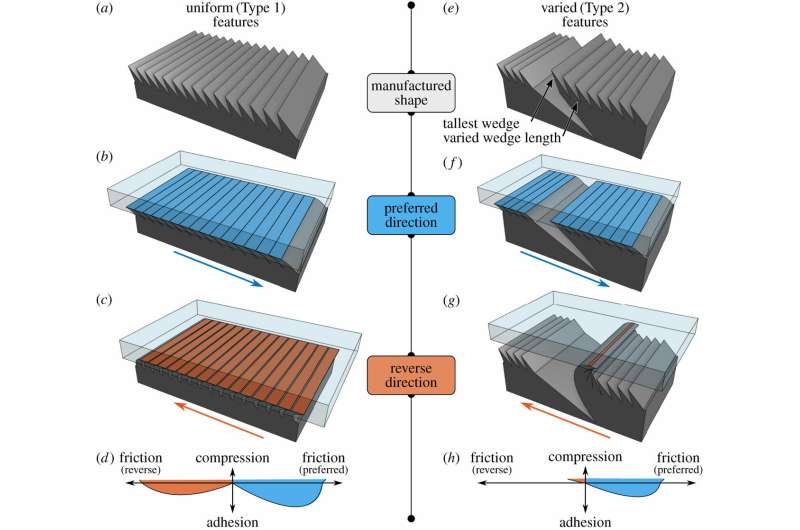January 30, 2019 report
Microstructured material with spatial variation has friction in only one direction

A team of researchers from Stanford University and the University of California has developed a microstructured material with spatial variation causing friction in only one direction. In their paper published in Journal of the Royal Society Interface, the group describes the inspiration for the new material and some possible ways it might be used.
The work builds on prior studies on geckos, which can attach easily to a pane of glass and then separate easily. This ability is due to the setae on gecko toes, which grip in only one direction—the hair-like structures all curve just one way. When spread out, they grip. But if they are turned around, they slide easily on the glass. In this new effort, the researchers sought to create a material that replicates this structure.
The material that the researchers created was made out of a silicone elastomer sculpted to have microscopic wedges on its surface. When the material is placed against another surface and pulled in one direction, the wedges are pulled down toward the surface, causing more friction. But when the material is pulled in the other direction, it slides. This happens because some of the wedges (randomly placed) are slightly longer than the others—when pulled in the opposite direction, they curl over the other wedges, pushing them away from the surface, causing the material to slide. The researchers explain that the randomly placed wedges are an example of spatial variation—something seen quite often in nature, but very seldom in manufactured materials.
The researchers note that spatial variation allows the gecko to climb windows and gives iridescence to some insects. It has also been found in some natural materials that exhibit hydrophobicity and others that have anti-drag properties. The researchers note that it is rarely found in manufacturing processes because the need for randomness increases production costs.
To test their new material, the researchers made an inchworm robot that does not need to pick up its feet. Instead, the one-way friction characteristic allowed the material to move in one direction with a simple downward push at its center.
More information: Srinivasan A. Suresh et al. Spatially variant microstructured adhesive with one-way friction, Journal of The Royal Society Interface (2019). DOI: 10.1098/rsif.2018.0705
Journal information: Journal of the Royal Society Interface
© 2019 Science X Network





















